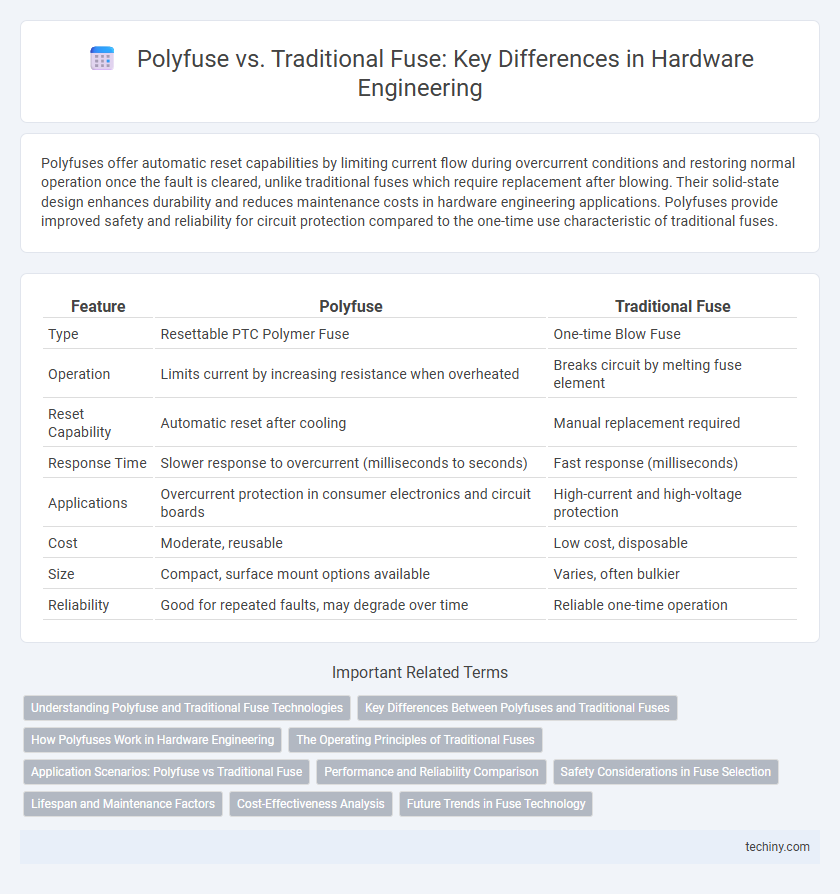Polyfuses offer automatic reset capabilities by limiting current flow during overcurrent conditions and restoring normal operation once the fault is cleared, unlike traditional fuses which require replacement after blowing. Their solid-state design enhances durability and reduces maintenance costs in hardware engineering applications. Polyfuses provide improved safety and reliability for circuit protection compared to the one-time use characteristic of traditional fuses.
Table of Comparison
| Feature | Polyfuse | Traditional Fuse |
|---|---|---|
| Type | Resettable PTC Polymer Fuse | One-time Blow Fuse |
| Operation | Limits current by increasing resistance when overheated | Breaks circuit by melting fuse element |
| Reset Capability | Automatic reset after cooling | Manual replacement required |
| Response Time | Slower response to overcurrent (milliseconds to seconds) | Fast response (milliseconds) |
| Applications | Overcurrent protection in consumer electronics and circuit boards | High-current and high-voltage protection |
| Cost | Moderate, reusable | Low cost, disposable |
| Size | Compact, surface mount options available | Varies, often bulkier |
| Reliability | Good for repeated faults, may degrade over time | Reliable one-time operation |
Understanding Polyfuse and Traditional Fuse Technologies
Polyfuses are resettable polymeric positive temperature coefficient (PTC) devices that protect circuits by increasing resistance with temperature, allowing automatic recovery after fault conditions, unlike traditional fuses which rely on a metal wire that melts to break the circuit permanently. Traditional fuses provide one-time protection by physically breaking the circuit when current exceeds a predefined threshold, necessitating replacement after activation. Polyfuses offer advantages in maintenance-free protection and reliability in repeated fault scenarios, whereas traditional fuses are preferred for precise one-time current interrupt capabilities in hardware engineering applications.
Key Differences Between Polyfuses and Traditional Fuses
Polyfuses, also known as polymeric positive temperature coefficient (PTC) devices, reset themselves after overheating, unlike traditional fuses which require replacement once blown. Polyfuses provide overcurrent protection by increasing resistance at elevated temperatures, allowing current to drop without interrupting the circuit permanently. Traditional fuses rely on a metal filament that melts to break the circuit, offering faster response but single-use protection.
How Polyfuses Work in Hardware Engineering
Polyfuses, also known as polymeric positive temperature coefficient (PPTC) resettable fuses, limit current by increasing resistance as temperature rises due to excessive current flow. Unlike traditional fuses that physically break the circuit by melting a metal wire, polyfuses heat up and expand their polymer matrix, reducing conductivity and protecting hardware components without needing replacement. This self-resetting characteristic makes polyfuses ideal for repeated overcurrent protection in hardware engineering applications such as circuit boards and power supplies.
The Operating Principles of Traditional Fuses
Traditional fuses operate by utilizing a thin metal wire or strip that melts when excessive current flows through it, thereby interrupting the circuit and protecting electronic components from damage. The melting point of the metal is carefully selected based on the desired current rating, ensuring fast response to overloads or short circuits. Unlike polyfuses that reset after cooling, traditional fuses are single-use devices requiring replacement once they have blown.
Application Scenarios: Polyfuse vs Traditional Fuse
Polyfuses excel in applications requiring resettable overcurrent protection, such as in consumer electronics and USB devices, where automatic recovery after fault conditions enhances user convenience and reduces maintenance. Traditional fuses are preferred in high-current industrial environments and critical safety systems due to their reliable one-time operation and clear failure indication. Choosing between polyfuse and traditional fuse depends on the need for resettable protection, response time, and cost-efficiency within specific hardware engineering scenarios.
Performance and Reliability Comparison
Polyfuses offer superior performance with self-resetting capabilities, enhancing circuit protection without the need for replacement after a fault. Traditional fuses provide high reliability under high current surges but require manual replacement once blown, leading to potential downtime. Polyfuses exhibit consistent resistance changes and reduced thermal stress, increasing system longevity in comparison to the one-time-use traditional fuses.
Safety Considerations in Fuse Selection
Polyfuses offer resettable protection by automatically limiting current during overloads, reducing the need for fuse replacements and enhancing safety in hardware systems. Traditional fuses provide a one-time, clear-cut break in the circuit, ensuring rapid disconnection but requiring manual replacement after activation. Selecting fuses involves evaluating system requirements for fault current interruption speed, reset capability, and reliability to balance protection and maintenance in electronic hardware design.
Lifespan and Maintenance Factors
Polyfuses offer a significantly longer lifespan compared to traditional fuses due to their self-resetting capability, which reduces the need for replacement after transient overcurrent events. Traditional fuses require physical replacement once blown, leading to increased maintenance efforts and downtime in hardware systems. Polyfuses also minimize maintenance costs and improve device reliability by automatically restoring circuit protection without manual intervention.
Cost-Effectiveness Analysis
Polyfuses offer a cost-effective solution by providing automatic reset capabilities, reducing the need for replacement and maintenance compared to traditional fuses. Traditional fuses incur recurring costs due to one-time use and require manual replacement after each fault event. The initial cost of polyfuses can be higher, but their long-term savings in labor, downtime, and replacement parts typically outweigh upfront expenses in hardware engineering applications.
Future Trends in Fuse Technology
Polyfuse technology is advancing rapidly with enhanced self-resetting capabilities, offering improved protection for increasingly compact and complex electronic devices. Future trends emphasize integrating smart fuses with real-time monitoring and adaptive response systems, crucial for IoT and automotive industries. Traditional fuses are gradually being supplemented or replaced by polyfuses due to their scalability, reliability, and environmental benefits in next-generation hardware engineering.
Polyfuse vs Traditional Fuse Infographic

 techiny.com
techiny.com